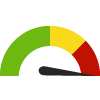Indicator Gauge Icon Legend
Legend Colors
Red is bad, green is good, blue is not statistically different/neutral.
Compared to Distribution
 the value is in the best half of communities.
the value is in the best half of communities.
 the value is in the 2nd worst quarter of communities.
the value is in the 2nd worst quarter of communities.
 the value is in the worst quarter of communities.
the value is in the worst quarter of communities.
Compared to Target
 meets target;
meets target;  does not meet target.
does not meet target.
Compared to a Single Value
 lower than the comparison value;
lower than the comparison value;
 higher than the comparison value;
higher than the comparison value;
 not statistically different from comparison value.
not statistically different from comparison value.
Trend

 non-significant change over time;
non-significant change over time; 
 significant change over time;
significant change over time;  no change over time.
no change over time.
Compared to Prior Value
 higher than the previous measurement period;
higher than the previous measurement period;
 lower than the previous measurement period;
lower than the previous measurement period;
 no statistically different change from previous measurement period.
no statistically different change from previous measurement period.
 Significantly better than the overall value
Significantly better than the overall value
 Significantly worse than the overall value
Significantly worse than the overall value
 No significant difference with the overall value
No significant difference with the overall value
 No data on significance available
No data on significance available
Hospital Admission Rate due to Drug Overdose
This indicator is archived and is no longer being updated. Click to learn more
Why is this important?
Drug abuse and its related problems are among society's most pervasive health and social concerns. Causes of drug-induced overdoses include dependent and non-dependent use of drugs (both legal and illegal use) and also poisoning from medically prescribed drugs. Addicted persons frequently engage in self-destructive and criminal behavior, which can result in injury or death. In addition, recreational drug-use can lead to unintentional overdose and death.
The majority of drug overdose deaths involve an opioid, and at least half of all opioid overdose deaths involve a prescription opioid. Since 1999, the rate of overdose deaths involving opioids (including prescription opioid pain relievers and heroin) nearly quadrupled. We now know that overdoses from prescription opioid pain relievers are a driving factor in the increase in opioid overdose deaths. (Centers for Disease Control and Prevention)
Measurement period: 2018
Maintained by: Conduent Healthy Communities Institute
Last update: November 2023
Graph Selections
| County | Source | Measurement Period | Admissions per 100,000 population | |
|---|---|---|---|---|
Data Source
- Oregon Health Authority, Public Health Division
Maintained By: Conduent Healthy Communities Institute (Methodology)
Filed under: Health / Alcohol & Drug Use, Clinical Care





